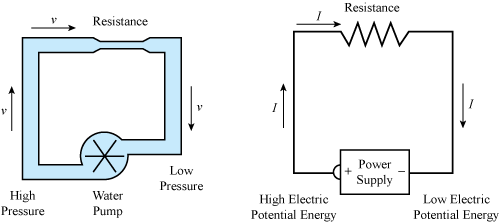Mahi Tuatahi / Do Now 🔗
Homework booklet Electric Fields Question Five
So far we have covered the concepts of:
- Charge carriers (electrons or otherwise),
- movement of charge carriers as current,
- charge carriers as the movers of energy,
- voltage as a difference in electric potential energy.
Pātai: What is the third variable that we are missing?
Resistance 🔗
- Charge carries want to move around a circuit, and in a conductor they can do this easily due to the mobile electrons.
- In insulators they are not as able to move due to the less mobile electrons.
- Resistance is the idea of a friction that the current encounters that reduces the current able to flow, and causes energy to be lost/used as heat/light.
- In reality, everything is a little bit of a resistor.

Symbol & Units 🔗
- Resistance has symbol R in equations and has the unit Ohms ($\Omega$, the Greek letter omega).
- Resistance changes when circuit components are added/removed or when a rheostat (variable resistor) is altered
- If supply voltage is constant, the current will increase/reduce as the resistance changes.
Resistance & Heat 🔗
When current moves through a material with resistance the electrons bump into other atoms. This causes energy to be transferred in the form of vibrations (heat)!
- The higher the resistance, the more heat produced!
- The higher the current, the more heat produced!
Ohm’s Law 🔗
$$ \begin{aligned} V &= IR \newline voltage &= current \times resistance \end{aligned} $$
- Voltage is measured in:
- Current is measured in:
- Resistance is measured in:
Pātai 🔗
- The resistance of a light bulb is $1.5k\Omega$. Calculate the current through the bulb when it is connected across a $12V$ power supply.
- When $9V$ is applied to a resistor, $0.03mA$ of current flows through it. Calculate the resistance of the resistor.
- How much voltage is required to produce $180\mu A$ of current flowing through a $0.6M\Omega$ resistor?
Whakatika Tahi 🔗
The resistance of a light bulb is $1.5k\Omega$. Calculate the current through the bulb when it is connected across a $12V$ power supply.
$$ \begin{aligned} & V = IR \newline & I = \frac{V}{R} \newline & I = \frac{12}{1500} \newline & I = 0.008A \end{aligned} $$
Whakatika Rua 🔗
When $9V$ is applied to a resistor, $0.03mA$ of current flows through it. Calculate the resistance of the resistor.
$$ \begin{aligned} & V = IR \newline & R = \frac{V}{I} \newline & R = \frac{9}{0.00003} \newline & R = 300000\Omega \end{aligned} $$
Whakatika Toru 🔗
How much voltage is required to produce $180\mu A$ of current flowing through a $0.6M\Omega$ resistor?
$$ \begin{aligned} & V = IR \newline & V = (180 \times 10^{-6}) \times (0.6 \times 10^{6}) \newline & V = 108V \end{aligned} $$
Power 🔗
Similar to Mechanics, power is defined as the amount of energy transferred (work done) per second, and is measured in $Js^{-1}$ or $W$.
$$ \begin{aligned} P &= IV \end{aligned} $$
The more power a component uses, the more energy is transformed (e.g. into light, heat, etc.)
Pātai 🔗
Revisit the three pātai you did just before and calculate the power dissapated (used) by the bulb and two resistors.
Confirming Ohm’s Law 🔗
- Collect a Confirming Ohm’s Law from the front.
- In small groups, set up a station with a hardmat to protect the bench.
- Vary the voltage across the resistor and record the current.
- Use the gathered data to complete Task 1-2.